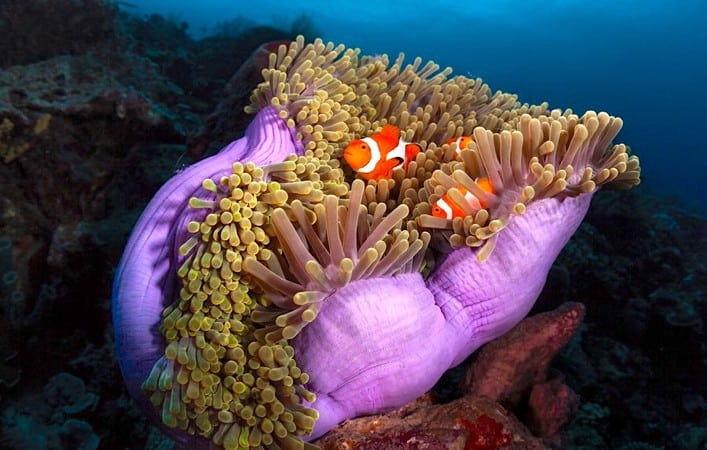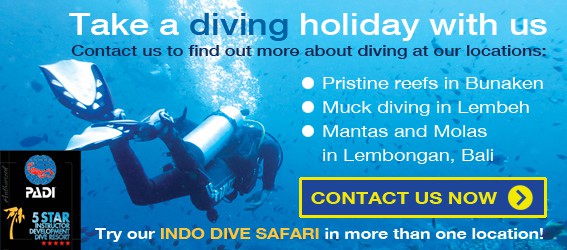What is Symbiosis?
Have you ever noticed two entirely different marine species which always seem to be spotted together? Have you ever wondered why?
Beneath the sea there are many interesting partnerships between species which are known as “symbiotic relationships”. When two different species are living and working together in a symbiotic relationship (also known as “living in symbiosis”) it means that they are both mutually benefitting from the presence of the other. Some of these relationships are well known, whereas others are slightly more cryptic and you might be surprised by some of the benefits which are derived. Here are SEVEN of our favourite symbiotic relationships which we see at our dive sites across Indonesia….
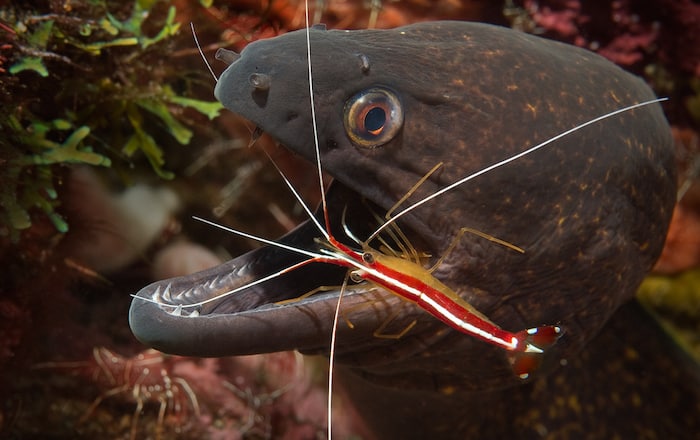
Cleaner shrimp clean parasites from moray eels in return for a free meal
Cleaner shrimp and moray eels
My oh my, what big teeth you have – and what a brave little shrimp! Moray eels will actively seek out cleaner shrimps on the reef during the day. The moray eel will give a free a meal to any shrimp which cleans it of its parasitic load. Cleaner shrimp are usually especially keen on cleaning around the moray eel’s eyes, gills, teeth – even bravely entering the eel’s mouth to ensure thorough teeth cleaning session and a decent meal!

Remoras (Suckerfish) travel in tandem with sea turtles
Turtles and Remoras
Remoras are also known as “suckerfish” and they are often seen attached to large marine species including sharks, rays and sea turtles. When you dive at Two Fish Divers on Bunaken Island in North Sulawesi you’ll see huge green sea turtles which often have remoras attached to them. Remoras have a sucking disk on their heads which they use to attach themselves to their host. They do not have swimming bladders so they rely on their hosts to help them travel the oceans! This technique also ensures swift water movement over their gills which is vital for breathing. The remora will eat the leftovers of their host’s meals and collect parasites and bacteria from their host’s skin – which keeps the host clean and healthy!
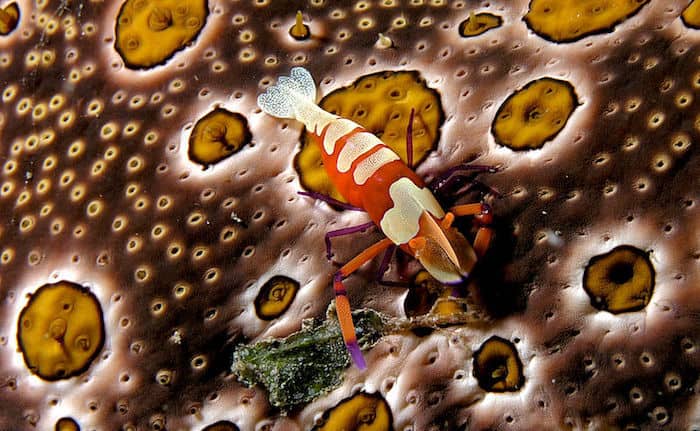
Emperor shrimp are given protection and a food source by sea cucumbers
Emperor shrimps, Nudibranch and Sea Cucumbers
Emperor shrimps (Periclimenes imperator) develop symbiotic relationships with a range of nudibranchs and holothurians or sea cucumbers. The shrimp lives on the surface of the host, which offers him protection from predators and an extra source of food. The relationship benefits the host too, as the shrimp consumes any parasites on its skin. The shrimp doesn’t stay still, but constantly moves up and down its host, looking for food from the substrate that has been disturbed by the host.

Anemones and anemonefish are an iconic example of symbiosis
Anemonefish and Anemones
This is one of the most iconic examples of symbiosis in the marine world and one which you will see over and over again while diving in Indonesia. Almost all of our dive sites in Bunaken, Lembeh, Amed, Gili Air, Nusa Lembongan and South Lombok are home to a plethora of anemones. Unlike in the movie Finding Nemo, clownfish seldom stray far from their anemone. During the day, they dart through the water overhead to catch morsels of food. At night, they snuggle deeply within the stinging tentacles for protection from predators.
The anemone benefits too as the clownfish chase away butterflyfish that would otherwise eat the anemone. Anemonefish also fertilise the anemone with their ammonia-rich waste and they keep the anemone aerated with oxygen by darting in and out of the tentacles which keeps a fresh supply of seawater flowing over and through the anemone, helping it to breathe!

The goby warns the blind shrimp when a predator approaches
Blind shrimps and Gobies
On our sandy sites it’s not unusual to see a shrimp and a goby living together in symbiosis. The shrimp will be digging out a burrow while the goby usually sits in the sand just in front of the burrow’s mouth. While the shrimp works away shovelling sand from the hole the goby appears to be getting the better end of the deal. However, the truth is that the goby is watching out for predators and will warn the shrimp when danger is nearby. The shrimps are completely blind and rely on the goby to alert them with a twitch of their tails when a potential predator is in the vicinity. Once the shrimp has been alerted it will stay in the burrow until it is safe to start work again.

Dive guides will often see the brightly coloured bannerfish before the mola
Mola and Schooling Bannerfish
Have you ever wondered how our talented Two Fish Dive Guides seem to be able to predict a mola sighting before it happens? They might not have a crystal ball but they have the know-how! Mola come to the reefs around Nusa Penida and Nusa Lembongan carrying heavy parasitic loads which build up on their skin during their time in deep waters. Mola visit the reefs and shallow waters to rewarm and to get cleaned. Schooling bannerfish are one of the species which are well known for cleaning mola and it’s not unusual to see small schools of bannerfish surrounding each mola. The schooling bannerfish are more brightly coloured than the mola and are usually what our guides will see first. If you see an accumulation of bannerfish off the reef between July and November there is a good chance there is a mola in the vicinity too. Other fish which are known mola cleaners include pyramid butterflyfish and even angelfish!
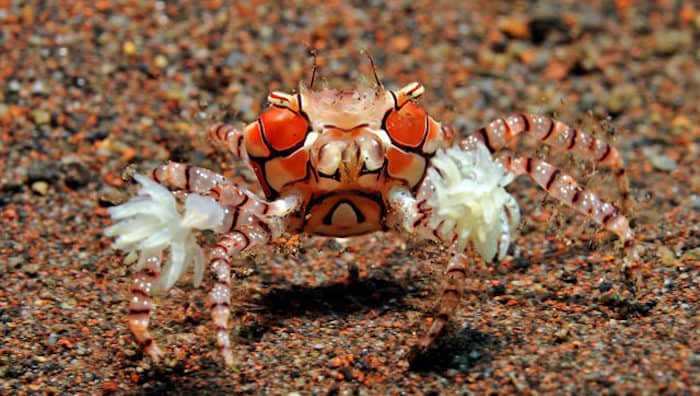
Boxer crabs are a special find and a wonderful example of symbiosis
Boxer Crab and Anemone Symbiosis
Boxer Crabs (AKA Pom-Pom Crabs) take their name from the small anemones which they hold in their claws, which resemble boxing gloves. The boxer crab uses the anemones to fend off predators which the anemone’s tentacles will sting. The anemones benefit too as they eat up the scraps left over by the crab when it has finished eating! This is a unique display of symbiosis and one which we find most often at our Two Fish Divers resort in Lembeh, North Sulawesi.
How many of these unique relationships have you seen for yourself? There are so many more examples of marine symbiosis which we see every day at our dive sites! Are you keen to capture some of these moments on camera? Both Two Fish Divers Lembeh Resort and Two Fish Divers Amed Resort offer phenomenal macro photography opportunities, abundant and diverse critters and numerous examples of symbiosis. Check out our muck diving special offers (and other special offers) on our Special Offers Page here!
If you’d like to know more about the incredible marine life which inhabits our stunning dive sites, or to make a reservation for any of our Two Fish Divers resorts, fill in the form below and we’ll get right back to you.

